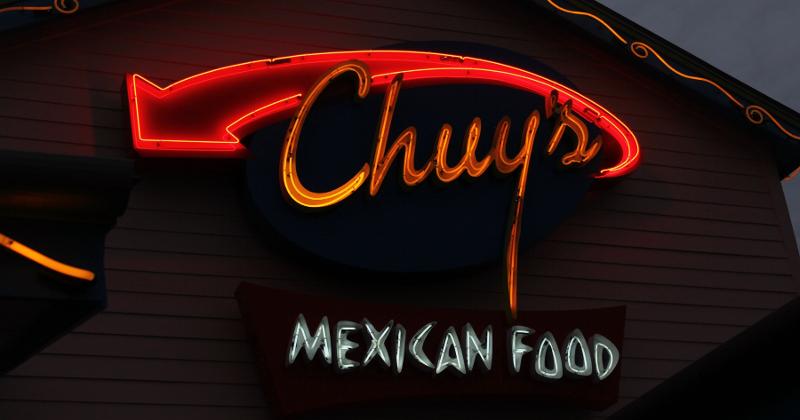
Visitors to Chuy’s Tex-Mex won’t find any discounts on the menu. But they can get a burrito as big as their face for $12.99 any day of the week, which is not bad for a sit-down meal these days.
It is this distinction between discounting and value that the 102-unit casual-dining chain is hoping to tease out for consumers, who have been paying fewer visits to its restaurants recently. In the first quarter, Chuy’s traffic was down nearly 7% year over year, part of a widespread decline in restaurant guest counts this year.
“We need to be screaming value a little bit, because we don't discount and we never will discount,” said CEO Steve Hislop at the Stifel Cross Sector Insight Conference last week, according to a transcript from financial service site AlphaSense.
It comes as many of Chuy’s competitors have turned to discounting to attract customers, who are increasingly replacing restaurant visits with cheaper meals at home. Deals such as Chili’s $10.99 3 for Me and all-you-can-eat wings at Buffalo Wild Wings have proven effective at boosting traffic, while McDonald’s and Starbucks are preparing to launch meal bundles of their own.
“You can eat on our menu all day long for 2 for $20, but I still need to get that message out.” —Steve Hislop, Chuy's Tex-Mex
Some restaurants choose not to discount to protect their margins, or because their prices are low to begin with. Others want to be viewed as a more premium option. But the broader shift toward discounting is forcing even some non-discount concepts to change their tactics.
“The environment has moved away from a branding message, an awareness message, to being more promotional and traffic driving,” observed Greg Levin, CEO of BJ’s Restaurants, during the Oppenheimer Consumer Growth and Ecommerce Virtual Conference on Monday, according to an AlphaSense transcript.
At the 217-unit BJ’s, marketing has typically focused on the experience customers can expect at its laid-back brewpubs, or on its unique Pizookie dessert. But the industry’s preoccupation with price, and BJ’s own traffic declines, is pulling it in a different direction. It plans to put more promotional muscle behind happy hour and its Daily Brewhouse Specials, such as half-off pizzas on Mondays and $5 Pizookies on Tuesdays, as it looks to appeal to lower-income guests.
“I do think the messaging starts to change a little bit more about telling the value that we already have on our menu versus the messaging around pure experiential,” Levin said.
Chuy’s is making a similar shift in its communications strategy. The Austin-based chain has historically touted its made-from-scratch menu as its biggest differentiator. But now the chain will do more to highlight its prices, which are on the lower end of the spectrum for casual dining.
“A lot of people are out there doing 2 for $20s and all that type of stuff,” Hislop said. “Well, you can eat on our menu all day long for 2 for $20, but I still need to get that message out.”
“We're focused on the everyday value piece. We're not a discounting brand.” —Chris Tomasso, First Watch
Other brands are looking at menu development as a place to create value and interest for customers. It is a move that has worked for The Cheesecake Factory, which changes its massive menu twice a year.
“This ongoing menu innovation drives a high degree of relevance without having to discount,” said President David Gordon at the William Blair Growth Stock Conference last week, according to an AlphaSense transcript. In the first quarter, Cheesecake's traffic was down 1.5%, which it blamed solely on bad weather.
At daytime-dining chain First Watch, where traffic slid 4.5% in Q1, the brand is taking the counterintuitive approach of using familiar but higher-priced items to get more customers in the door. It is bringing back premium limited-time offers from the past, such as shrimp and grits, in hopes that the old favorites will draw in regulars looking for a meal they know they can count on.
That effort will run parallel to the chain's focus on giving customers built-in value via low prices. The Bradenton, Florida-based chain has raised its prices at a slower rate than others—about 3.5% a year since the pandemic.
“We're focused on the everyday value piece,” said CEO Chris Tomasso during the chain’s first quarter earnings call last month, according to AlphaSense. “We're not a discounting brand, we haven't been for our 40-year history and we've been through all kinds of economic environments and have stayed true to who we are.”
Value will also dictate menu strategy at BJ’s, which will focus more on check-boosting add-ons, such as appetizers and cocktails, rather than new entrees.
“How much do we want to lean into things like surf and turf versus how much do we want to lean into things that might drive additional incidence?” Levin said.
Members help make our journalism possible. Become a Restaurant Business member today and unlock exclusive benefits, including unlimited access to all of our content. Sign up here.